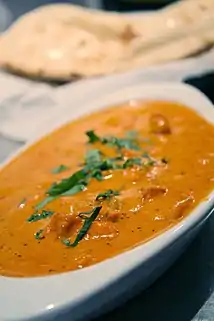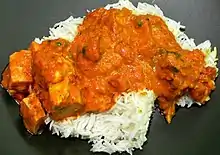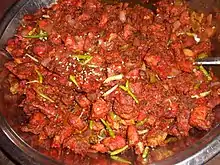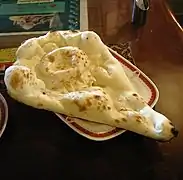Chicken tikka masala
Chicken tikka masala is a dish consisting of roasted marinated chicken chunks (chicken tikka) in spiced curry sauce. The curry is usually creamy and orange-coloured.
 Chicken tikka masala | |
| Course | Main course |
|---|---|
| Place of origin | United Kingdom |
| Serving temperature | Hot |
| Main ingredients | Chicken, yogurt, cream, tomato, onion, garlic, ginger, chili pepper |
| Variations | Lamb, fish or paneer tikka masala |


Composition
Chicken tikka masala is composed of chicken tikka, boneless chunks of chicken marinated in spices and yogurt that are roasted in an oven, served in a creamy curry sauce.[1][2] A tomato and coriander sauce is common, but no recipe for chicken tikka masala is standard; a survey found that of 48 different recipes, the only common ingredient was chicken.[3][4] The sauce usually includes tomatoes (frequently as purée), cream, coconut cream and a masala spice mix. The sauce and chicken pieces may be coloured orange using foodstuffs such as turmeric, paprika, tomato purée or with food dye. The dish shares some similarity with butter chicken, both in the method of creation and appearance.
Origins
The origin of the dish is not certain. Some trace it to the South Asian community in Scotland and others claim that it originated in the Indian subcontinent.
Chicken Tikka Masala is more likely derived from butter chicken, a popular dish in northern India. Some observers have called chicken tikka masala the first widely accepted example of fusion cuisine.[2] Whatever the various claims, the Moti Mahal restaurant can be seen as the true origins of Chicken tikka masala in its basic form of Butter Chicken. Lal Kundan Lal Gujral first set up in Peshawar in 1920 but came to Delhi in 1947 to set up Moti Mahal. He worked with a local man to produce the first restaurant version of the tandoor and invented tandoori spice mix for tandoori chicken -ground coriander seeds, black pepper and mild red pepper. Called Murgh Makhani in Hindi, Butter Chicken originated in the 1950s at the Moti Mahal restaurant in Old Delhi.[5] The Multicultural Handbook of Food, Nutrition and Dietetics credits its creation to Bangladeshi migrant chefs in the 1960s, after migrating to Britain from what was then East Pakistan (now Bangladesh). At the time, these migrant chefs developed and served a number of new inauthentic ‘‘Indian’’ dishes, including chicken tikka masala.[6]
Historians of ethnic food, Peter and Colleen Grove, discuss multiple origin-claims of chicken tikka masala, concluding that the dish "was most certainly invented in Britain, probably by a Bangladeshi chef".[7] They suggest that "the shape of things to come may have been a recipe for Shahi Chicken Masala in Mrs Balbir Singh’s Indian Cookery published in 1961".[7]
Rahul Verma, a food critic who writes for The Hindu,[8] said he first tasted the dish in 1971 and that its origins were in Punjab, India. He said "It's basically a Punjabi dish not more than 40–50 years old and must be an accidental discovery which has had periodical improvisations".[9][10]
Another explanation is that it originated in a restaurant in Glasgow, Scotland.[10][1] This version recounts how a British Bangladeshi chef, Ali Ahmed Aslam, proprietor of the Shish Mahal restaurant in Glasgow,[11] invented chicken tikka masala by improvising a sauce made from yogurt, cream, and spices.[12][13] In 2013, his son Asif Ali told the story of its invention in 1971 to the BBC's Hairy Bikers TV cookery programme:[14]
On a typical dark, wet Glasgow night, a bus driver coming off shift came in and ordered a chicken curry. He sent it back to the waiter saying it's dry. At the time, Dad had an ulcer and was enjoying a plate of tomato soup. So he said why not put some tomato soup into the curry with some spices. They sent it back to the table and the bus driver absolutely loved it. He and his friends came back again and again and we put it on the menu.[14]
Popularity
Chicken tikka masala is served in restaurants around the world,[15][16] including Indian restaurants in the United Kingdom and North America. According to a 2012 survey of 2,000 people in Britain, it was the country's second-most popular foreign dish to cook, after Chinese stir fry.[17]
In 2001, British Foreign Secretary Robin Cook mentioned the dish in a speech acclaiming the benefits of Britain's multiculturalism, declaring:
Chicken tikka masala is now a true British national dish, not only because it is the most popular, but because it is a perfect illustration of the way Britain absorbs and adapts external influences. Chicken tikka is an Indian dish. The masala sauce was added to satisfy the desire of British people to have their meat served in gravy.[18][19][20][21][22]
See also
- Balti, a South Asian dish
- Chicken curry, a spiced chicken dish
- Butter chicken, a mild curry dish of Indian origin
- List of chicken dishes
- Mughlai cuisine
References
- Lloyd, J and Mitchinson, J. The Book of General Ignorance. Faber & Faber, 2006
- Siciliano-Rosen, Laura; Rogers, Kara. "Chicken tikka masala". Encyclopaedia Britannica. Retrieved 28 December 2020.
- Jackson, Peter (2010). A Cultural Politics of Curry in "Hybrid Cultures, Nervous States: Britain and Germany in a (post)colonial World". Amsterdam: Rodopi BV. p. 172. ISBN 9789042032286. Retrieved 3 June 2014.
- Webb, Andrew (2011). Food Britannia. Random House. p. 177. ISBN 978-1847946232. Retrieved 3 June 2014.
- http://monishgujral.com/an-homage-to-chicken-tikka-masala/
- Thaker, Aruna; Barton, Arlene (2012). Multicultural Handbook of Food, Nutrition and Dietetics. John Wiley & Sons. p. 74. ISBN 9781405173582.
- Grove, Peter; Grove, Colleen (2008). "Is It or Isn't It? (The Chicken Tikka Masala Story)". Menu Magazine. Grove Publications. Archived from the original on 27 November 2016. Retrieved 19 May 2017.
- "Author profile: Rahul Verma". The Hindu. Retrieved 13 May 2017.
- Nelson, Dean; Andrabi, Jalees (4 August 2009). "Chicken tikka masala debate grows as Indian chefs reprimand Scottish MPs over culinary origins". The Daily Telegraph. London. Retrieved 28 April 2010.
- "From Charles Mackintosh's waterproof to Dolly the sheep: 43 innovations Scotland has given the world". The Independent. 30 December 2016.
- Campaign to establish the priority of Glasgow
- "Glasgow 'invented' Tikka Masala". BBC News. BBC. 21 July 2009. Retrieved 19 May 2017.
- Godeau, Lucie (2 August 2009). "Chicken tikka masala claims its origins in Scotland". Sydney Morning Herald. Agence France Presse. Retrieved 19 May 2017.
- BBC Hairy Bikers' Best of British Series 2: 5. Food and the Empire. First shown: 6.30pm 5 April 2013
- Kumar, Rakesh (24 February 2007). "Tastes that travel". The Hindu. Chennai, India: Kasturi & Sons Ltd. Retrieved 19 May 2017.
- Aravind Adiga (20 March 2006). "The Spice of Life". Time. Retrieved 1 June 2007.
- "Stir-fry now Britain's most popular foreign dish". Daily Mirror. 21 January 2012.
- "Robin Cook's chicken tikka masala speech: Extracts from a speech by the foreign secretary to the Social Market Foundation in London". The Guardian. 19 April 2001.
- Mannur, Anita (2009). Culinary Fictions: Food in South Asian Diasporic Culture. Temple University Press. p. 3. ISBN 978-1-4399-0077-2.
- Collingham, E. M. (2006). Curry: A Tale of Cooks and Conquerors. Oxford; NY: Oxford University Press. p. 2. ISBN 0-19-517241-8.
- Jo Monroe, Star of India: The Spicy Adventures of Curry (Wiley: 2005 ISBN 9780470091883) pp. 136-137.
- Collingham, Elizabeth M. (2006). Curry: A Tale of Cooks and Conquerors. Oxford University Press. pp. 2–12. ISBN 0-19-517241-8.
Further reading
External links
| Wikimedia Commons has media related to Chicken tikka masala. |
| Wikibooks Cookbook has a recipe/module on |


